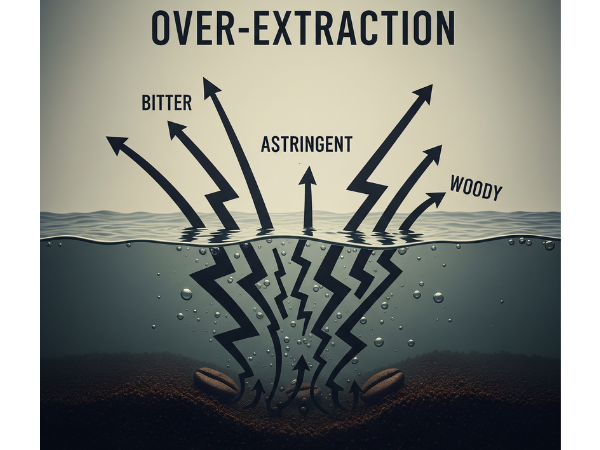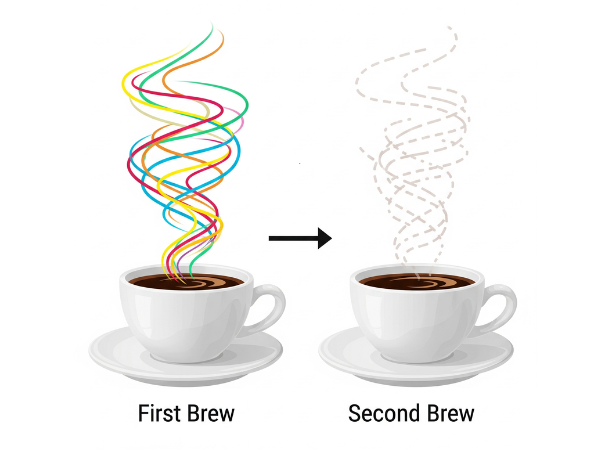Have you ever wondered if you can brew your coffee twice? It’s a question many coffee lovers ask, especially when trying to maximize flavor and minimize waste.
This guide you’ll discover the impact of double brewing on flavor and aroma. We’ll explore the benefits and drawbacks, helping you make an informed choice for your daily cup.
The Science Of Coffee Extraction: Why Once Is (Usually) Enough
Understanding the science of coffee extraction helps clarify why brewing coffee more than once is often not the best choice. Brewing coffee involves extracting flavors, aromas, and caffeine from the coffee grounds.
Understanding Coffee Solubility: What’s In The Grounds?
Coffee grounds contain soluble compounds that contribute to the drink’s flavor and aroma. These compounds include:
- Flavor compounds
- Aroma compounds
- Caffeine
Hot water extracts these solubles from the grounds. During the first brew, the most desirable compounds are extracted. Here is a breakdown of extraction during brewing:
| Stage of Extraction | Time (minutes) | Compounds Extracted |
|---|---|---|
| Initial Extraction | 0-2 | Sweetness, acidity, aroma |
| Mid Extraction | 2-4 | Flavor complexity, caffeine |
| Over Extraction | 4+ | Bitter, astringent flavors |
The first brew captures the best qualities of coffee. Prolonged contact with water can extract undesirable compounds. These include bitter, astringent, and woody flavors.
The Role Of “Over-Extraction”: What Happens Next?
Over-extraction occurs when coffee grounds are brewed for too long. This leads to undesirable flavors. The first brew extracts the best flavors, but the second brew can change this.
When brewing coffee a second time:
- The sweet and complex flavors diminish.
- Bitter and astringent notes become more prominent.
- The aroma may become flat or unpleasant.
Over-extraction can ruin the experience of drinking coffee. The negative flavors can overpower the original taste. This is why many coffee enthusiasts stick to a single brew.

The “Pros” Of Brewing Coffee Twice: Stretching Your Grounds
This method can help save money and possibly provide a slight caffeine boost. Let’s explore the benefits of brewing coffee twice.
Potential Economic Savings: Making Coffee Go Further
Brewing coffee twice can lead to significant savings. Using grounds a second time maximizes the use of these costly beans. This practice reduces overall coffee consumption costs.
Here are some key points on how brewing coffee twice can save you money:
- Stretching your grounds reduces the need for fresh coffee beans.
- Lower coffee expenses mean more money for other essentials.
- Enjoying two cups from one batch of grounds minimizes waste.
These savings can add up. By brewing coffee twice, you can enjoy your favorite beverage while keeping your budget intact.
Minimal Caffeine Boost (for Certain Applications)
Brewing coffee twice may provide a very small residual amount of caffeine. This could be useful for those wanting a mild caffeine lift. However, it is not a reliable source for a significant energy boost.
Consider these aspects when thinking about caffeine:
- Brewing twice extracts some flavor and caffeine.
- The second cup will taste milder.
- Could be considered for very mild flavorings.
Many enjoy the taste of coffee, even if it is less potent. Brewing coffee twice can suit those who prefer a lighter drink. It may not satisfy those needing a strong caffeine jolt.
The “Cons” Of Re-brewing: Flavor And Quality Degradation
This section explores the negative effects of brewing coffee a second time, focusing on taste, aroma, and potential health concerns.

Flavor Impact: Weak, Bitter, And Unpleasant Taste
Re-brewing coffee often results in a thin, watery, and bitter brew. The first brew extracts the desirable flavors from the coffee grounds. By the time you attempt a second brew, most of the good flavors are already gone.
Here’s a breakdown of what happens:
- Desirable flavors are already largely extracted in the first brew.
- Residual undesirable compounds become more pronounced.
- The second brew generally lacks richness and depth.
The dominant outcome is a brew that tastes weak and unsatisfying. It can even become unpleasant for those who enjoy a strong cup.
Aroma Loss: A Flat And Lifeless Cup
Aroma plays a crucial role in the coffee experience. When you brew coffee a second time, you lose much of the aroma. Most volatile aromatic compounds dissipate in the first brew.
Consider these key points:
- The second brew lacks the rich, inviting coffee scent.
- Aromas contribute significantly to the overall flavor perception.
- A coffee cup without aroma is often unappealing.
This loss of aroma leads to a generally unappealing sensory experience. Coffee lovers often crave the complex scents that accompany a well-brewed cup.
Health And Safety Concerns (minimal But Possible)
While re-brewing coffee may not pose major health risks, some concerns exist. Storing wet grounds can encourage bacterial growth. This may lead to health issues, especially if the coffee sits for an extended time.
Consider these precautions:
- Best to re-brew immediately or discard grounds quickly.
- Not a primary concern for most – but good to be aware.
- Using fresh grounds ensures a cleaner brew.
Though the health risks are minimal, it’s wise to prioritize cleanliness in your coffee-making routine. Enjoying coffee should be a delightful experience, free from any worries about safety.
Beyond Re-brewing: Smarter Ways To Use Your Grounds
Instead of re-brewing, explore smarter ways to use your coffee grounds. This approach not only enhances your coffee experience but also provides eco-friendly options.
Alternative Uses For Spent Coffee Grounds
Spent coffee grounds are not just waste. They have many practical uses. Here are some great ideas:
- Composting: Excellent for garden soil enrichment. They add nitrogen and improve soil structure.
- Odor Neutralizer: Absorbs smells in fridges or shoes. Place a bowl of grounds in your fridge to keep odors at bay.
- Pest Repellent: Coffee grounds can deter pests like slugs and snails in gardens.
- Cleaning Abrasive: Use grounds to scrub pots and pans. They help remove stubborn stains.
Using spent coffee grounds wisely can benefit your home and garden. These alternatives reduce waste and enhance your daily life.
Optimizing Your First Brew For Maximum Flavor
Getting the best flavor from your coffee starts with the first brew. Follow these tips for an optimal experience:
- Adjust grind size: Use a coarser grind for French press and a finer grind for espresso. This ensures optimal extraction.
- Control water temperature: Ideal brewing temperature is around 195°F to 205°F. This range helps to extract the right flavors.
- Use fresh, quality beans: Always choose high-quality beans. Freshness greatly affects the initial taste.
- Measure coffee and water: Use a standard ratio of 1:15. This balance offers the best flavor profile.
By focusing on these elements, you can enhance your coffee experience. Paying attention to grind size, water temperature, and bean quality makes all the difference.
